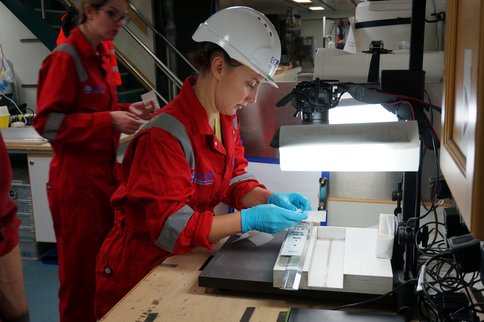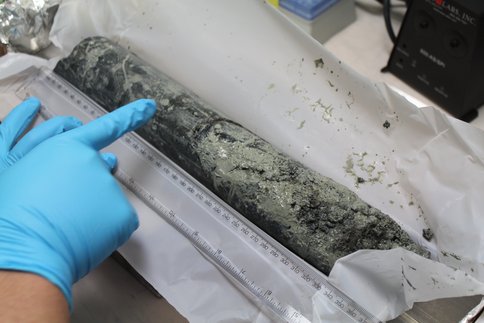2015 Annual Science Report
 University of Colorado, Boulder
Reporting | JAN 2015 – DEC 2015
University of Colorado, Boulder
Reporting | JAN 2015 – DEC 2015
RPL and Expedition 357: Serpentinization and Life at the Atlantis Massif
Project Summary
Circulating hydrothermal fluids associated with mid-ocean ridges represent some of the most prominent examples of the intersection between chemical energy and the biosphere. The Lost City Hydrothermal Field, which sits atop the Atlantis Massif near the Mid Atlantic Ridge hosts a microbial ecosystem which feeds off the products of serpentinization. IODP Expedition 357, which sailed in Fall 2015, obtained rock cores and fluids from the Atlantis Massif, which are being used for the coordinated investigation of serpentinization processes and life. Lost City is known to sustain abiogenic organosynthesis reactions and as such has been suggested to be an analogue to prebiotic early Earth environments and potential extraterrestrial habitats.
Project Progress
In January 2015, members of the RPL NAI team applied to be members of the IODP Expedition 357 Atlantis Massif: Serpentinization and Life science party. Project Lead Schrenk, Project Co-Investigators Brazelton, Mayhew and Twing were selected from a highly-competetive international pool of applicants. A majority of efforts in 2015 involved preparing for this expedition, with an team of collaborators that included participants from the US, France, Japan, Switzerland, Norway, and the UK. Monthly teleconferences were used to develop a detailed core workflow plan and to coordinate analyses.
IODP Expedition 357 sailed from 23 October until 11 December 2015 and successfully obtained core from 8 Sites atop the Atlantis Massif using the seabed rock drills RD2 (British Geological Survey) and MeBo (MARUM, Germany) aboard the RRS James Cook. Schrenk and Twing were part of a small number of the scientists that participated in the off-shore phase of expedition. Subsamples of the cores were taken during the expedition and used to initiate experiments while at sea. Fluid samples from deep seawater and hydrothermal plumes above the Atlantis Massif were also obtained. Project Lead Schrenk initiated cultivation experiments aimed at measuring carbon utilization under sulfate-reducing conditions. Successful experiments may yield novel extremophilic organisms from seafloor serpentinites that can be used for detailed physiological and phylogenetic analyses. Co-investigators Brazelton and Twing obtained numerous rock and fluid samples that will be used for detailed genomics analyses using next generation sequencng approaches. Co-investigator Mayhew will sub-sample pieces of core during the onshore sampling party for further geochemical analysis of water-rock reactions. Microscale mineralogical and geochemical (e.g. Fe oxidation state) analysis of these rocks will enable deciphering the pathways and products of low temperature water-rock reactions at the Atlantis Massif.
A majority of the detailed work and analyses will take place during the onshore sampling party in Bremen, Germany in January-February 2016, and during a microbiological sampling party at the Kochi Core Repository in Japan in February 2016. Major accomplishments of the cruise included technical developments to 1) obtain continuous cores of lower crustal and upper mantle rocks using the seabed drills, 2) deliver dissolved chemicals (PFC’s) into boreholes during drilling to trace contamination by drilling fluids, 3) conduct highly sensitive cell count and DNA chraracterization procedures to trace contamination by surface sources (e.g. seawater). Many of these advancements are highly relevant to work planned for the Oman Drilling Project at the Semail ophiolite, another a target field site of the RPL team. Furthermore, the firsthand experiences of the project team members with Exp. 357 will directly transfer to any future work at Oman and other field sites with astrobiological significance.
-
PROJECT INVESTIGATORS:
-
PROJECT MEMBERS:
William Brazelton
Co-Investigator
Lisa Mayhew
Co-Investigator
Katrina Twing
Co-Investigator
Lauren Seyler
Collaborator
-
RELATED OBJECTIVES:
Objective 3.1
Sources of prebiotic materials and catalysts
Objective 3.4
Origins of cellularity and protobiological systems
Objective 5.1
Environment-dependent, molecular evolution in microorganisms
Objective 5.2
Co-evolution of microbial communities
Objective 5.3
Biochemical adaptation to extreme environments
Objective 7.2
Biosignatures to be sought in nearby planetary systems


